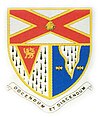Blackheath Proprietary School
 |
|
| Motto |
docendum et discendum "To be taught and to learn" |
|---|---|
| Established | 1830 |
| Closed | 1907 |
| Type | Proprietary School |
| Religion | Church of England |
| Location |
Blackheath Greenwich London England, United Kingdom 51°27′52″N 0°00′28″E / 51.46438°N 0.00781°ECoordinates: 51°27′52″N 0°00′28″E / 51.46438°N 0.00781°E |
| Gender | boys |
| Ages | 11–18 |
The Blackheath Proprietary School was an educational establishment founded in 1830 that was noted in the contemporary press as an extremely successful school in terms of its education but is perhaps most notable for its profound influence on the game of football, in both Association and Rugby codes. In 1863, the school became one of the founders of The Football Association.
The Blackheath Proprietary School was established in 1830 to give sound liberal education similar to the public schools of England. From its inception, it worked towards ensuring it had an educational reputation that would be the equivalent of its public school contemporaries and the school granted an exhibition of £50 per annum every two years to pupils proceeding to Oxford University, Cambridge University or Dublin University Blackheath's population had expanded rapidly in the 1820s, hence the timing of the establishment of the school. The school was founded on joint stock principles and there were originally 100 shares priced at £20 each; proprietorship of a share entitled its owner to send or nominate a boy to the school. From 1831 when it opened it was successful particularly under Reverend Edward Selwyn, an alumnus of Trinity College, Cambridge. He was head from 1849 to 1864 and remarkably in his last three years when there were more than 200 boys in the school, every boy in the upper sixth won an open scholarship to Oxford or Cambridge. The school also boasted a cadet corps. In 1880 a sister school was opened, Blackheath High School for girls, on Wemyss Road in order to provide a high standard of education, comparable to that in the flourishing Blackheath Proprietary School for boys, for the young women of Blackheath. The school was built at the initiative of local residents, but was run by the Girls Public Day School Company.
Although the Proprietary School flourished for much of the nineteenth century, it was threatened by a number of elements including the diminishing lease on its site, the popularity of boarding schools and the growing availability of day schools nearby. The school closed in 1907.
The school buildings were situated near Blackheath Park and in Lee Park and were described as "a handsome building after the model of the Propylaeum in Athens". The school's buildings were at the very top of the current Lee Road on its west side. The site was redeveloped in 1937 as Selwyn Court (this building caused much controversy in Blackheath and was a catalyst in the foundation of the Blackheath Society, which continues to vigorously campaign for the preservation of the character and quality of the area).
...
Wikipedia
